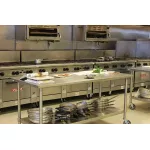Why Eco-Friendly Hand Sinks Matter
As the world grapples with environmental issues, businesses are increasingly expected to adopt sustainable practices. Eco-friendly hand sinks offer an opportunity to reduce the ecological footprint while also showcasing a commitment to responsible corporate citizenship. These sinks go beyond mere functionality; they become symbols of conscious decision-making.
Water-Efficient Faucets and Sensors
One of the key features of eco-friendly hand sinks is the incorporation of water-efficient faucets and sensors. These mechanisms regulate water flow, ensuring that only the necessary amount is used. This not only conserves water but also reduces utility costs for businesses.
Materials and Manufacturing
Sustainability begins with the materials used in manufacturing. Eco-friendly hand sinks are crafted from recyclable and biodegradable materials whenever possible. Manufacturers are exploring innovative options such as bamboo and reclaimed metals, reducing the demand for virgin resources.
Energy-Efficient Hand Dryers
In the quest for sustainability, energy-efficient hand dryers have become a common feature in modern hand sinks. These dryers utilize less energy, contributing to reduced operational costs for businesses and a lower carbon footprint.
Waste Reduction and Recycling
Eco-friendly hand sinks are designed with waste reduction in mind. Some models include compartments for recyclable waste, encouraging proper sorting and disposal. This holistic approach to waste management aligns with broader environmental goals.
Green Certifications and Compliance
Various green certifications, such as LEED, play a pivotal role in driving the adoption of sustainable hand sinks. Meeting these standards not only demonstrates commitment but also opens doors to a broader customer base that values eco-conscious choices.
Cost Savings and Return on Investment
While the initial investment in eco-friendly hand sinks might be slightly higher, the long-term cost savings are evident. Reduced water and energy consumption lead to significant savings over time, often outweighing the upfront expenditure.
Creating Awareness and Promoting Eco-Friendly Practices
Installing eco-friendly hand sinks is just the beginning. Businesses can further engage by educating customers and employees about the importance of sustainability. This creates a ripple effect, fostering conscious behaviors beyond the confines of the establishment.
Future Trends in Sustainable Hand Sinks
The landscape of sustainable hand sinks continues to evolve. Anticipated trends include advanced water purification systems, integration with smart technologies, and enhanced customization to suit diverse business needs.
Case Studies: Successful Implementation
Several businesses have successfully integrated eco-friendly hand sinks into their operations. These case studies underscore the positive impact on the environment, customer perception, and overall business reputation.
Challenges and Overcoming Hurdles
While the benefits are clear, there are challenges in transitioning to eco-friendly hand sinks. These include higher upfront costs, potential technical issues, and resistance to change. Businesses must devise strategies to address these hurdles.
Consumer Perception and Preferences
Consumers are increasingly favoring businesses that align with their values. Eco-friendly hand sinks contribute to a positive brand image, enhancing customer loyalty and attracting a socially conscious clientele.
The Role of Government and Regulations
Government regulations and incentives can significantly influence the adoption of eco-friendly hand sinks. By providing tax benefits and support, authorities can accelerate the shift towards sustainable practices.
Eco-friendly features in commercial hand sinks represent a meaningful step towards sustainability. By embracing water efficiency, energy conservation, waste reduction, and responsible manufacturing, businesses can make a tangible impact on the environment while reaping long-term benefits. The integration of these features is not just a trend but a necessary evolution in our approach to daily operations.


